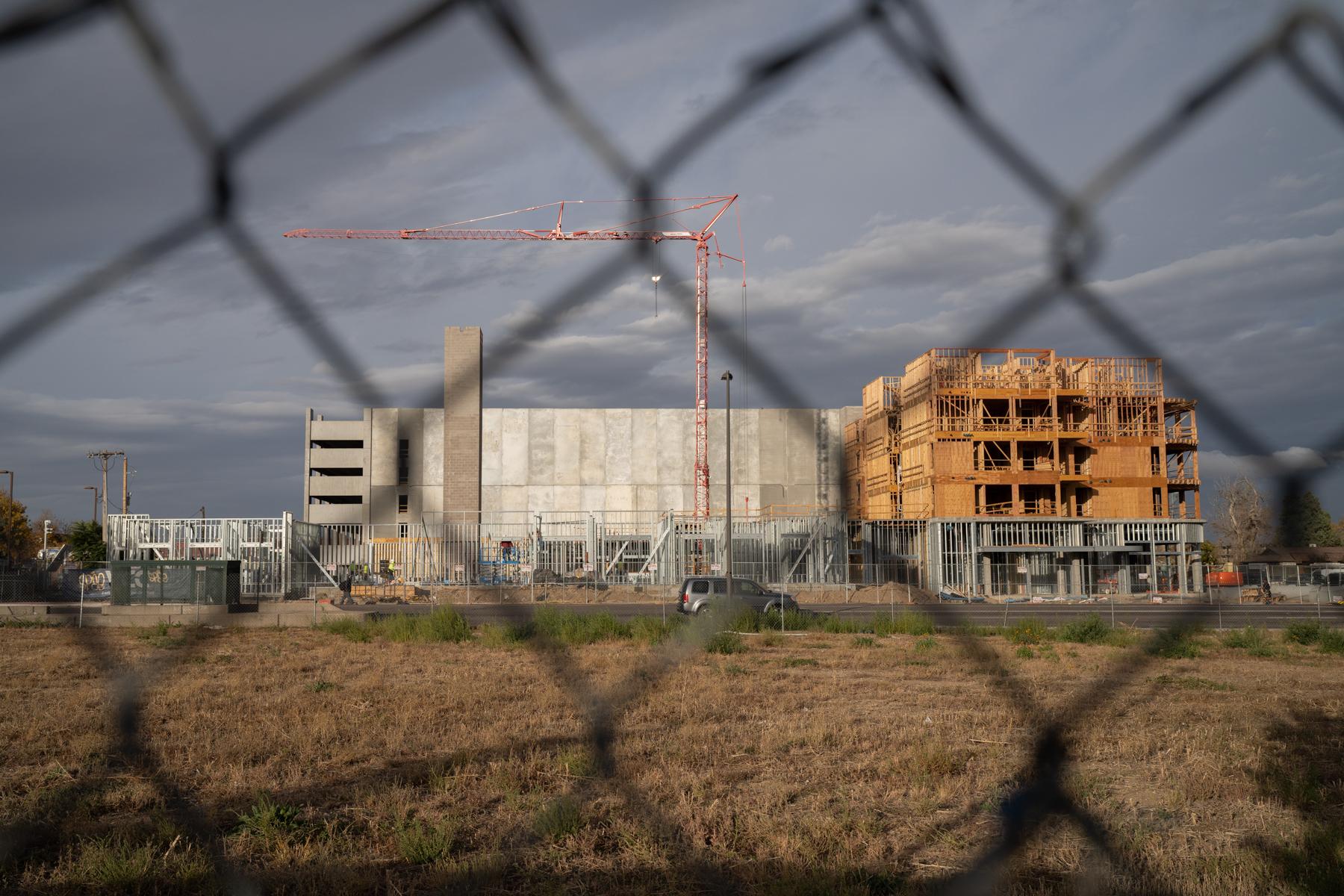
Updated 5:54 p.m. April 20, 2023
A Colorado Senate committee advanced a sprawling proposal late Tuesday night to reform Colorado’s local zoning codes, in order to boost housing production and promote density.
The sponsors, however, agreed to several significant revisions to the bill to keep it alive.
The centerpiece of the bill when it was introduced last month was an “upzoning” requirement that would have allowed denser development across large swaths of many cities. The idea drew intense opposition from local leaders, including many Democrats, because it overrides existing city laws.
On Tuesday, bill sponsors and members of the Senate Local Government and Housing Committee rolled back the measure’s ambitions. Instead of being forced to allow higher density in all their residential neighborhoods, Front Range cities would only have to upzone more limited areas.
“We are removing one of the biggest preemptions that folks have expressed concerns about,” Senate Majority Leader Dominick Moreno, a bill sponsor, told the committee Tuesday evening.
In all, after a lengthy delay as backers finalized their changes, the committee approved more than a dozen amendments. A summary and copies of many of those were provided to CPR News by Senate Democrats.
No more citywide 'middle housing'
Originally, upzoning would have allowed denser “middle housing” across 100 percent of the residential zones of designated communities, known as “Tier 1” cities in the language of the bill.
But under the amended bill, those cities would only have to allow middle housing “by right” on a limited amount of acreage. That would be determined by a new formula that requires greater density on at least 30 percent of the acreage where cities currently allow single family homes.
Local governments would be encouraged to place middle housing zones near transit and in walkable areas, while trying to minimize the risk of displacing existing residents.
The amendments also soften the definition of middle housing. Instead of allowing up to six units per lot, middle housing zoning would now mean four units per lot.
One thing that won’t change is the bill’s requirement that most cities allow accessory dwelling units in all residential areas. (See here for more detail on how different cities are categorized under the bill.)
Density reduced for key corridors
The original bill would require certain Tier 1 cities to allow even greater density — such as apartment blocks — along “key corridors.”
A key corridor is defined as the area within a quarter-mile of a road served by 15-minute bus service, like Colfax Avenue in Denver. The state Department of Transportation would identify and designate key corridors across the state.
The revisions scale back this proposal too. Instead of opening the door to that higher level of density along an entire corridor, cities would only have to upzone 25 percent of the corridor area. Those upzoned areas would have to allow a minimum of about 25 units per acre, roughly equivalent to a three-story apartment building.
However, cities would still have to allow the lesser “middle housing” density along an entire corridor. (Those parcels would count toward the 30 percent The bill also includes a measure that encourages — but does not require — cities to allow middle housing along these corridors. Cities that currently have large amounts of single-family zoning near key corridors and transit lines would have to create more middle housing than other cities.
The amendments also reduce the density requirement around rail transit stations. Originally, cities would have had to upzone all properties within a half mile of a station. Now, those highest density levels would only have to apply to fifty percent of the parcels within that radius.
Ski towns exempted
Originally, the bill’s various upzoning measures also applied to “rural resort” ski towns such as Crested Butte, Steamboat Springs and Vail.
Those cities are being written out of the main part of the bill. They would not be forced to allow multi-family housing, accessory dwelling units, or other new forms of density in residential areas.
They still would have to participate in the new state-run planning processes for housing needs, and they would have to choose from a list of affordability strategies. CPR News reported earlier on the ski-town changes.
Planning changes
Under the amendments, certain smaller and lower-income cities would be exempted from having to complete their own housing needs plans. Other cities would still have to analyze their housing stock and create plans every five years for how they will address shortages.
The amendments also establish a detailed “menu” of strategies to maintain housing affordability and prevent displacement as development, potentially, ramps up. Previously, those menus were going to be written by state regulators in the future.
Upzoning policies meant to boost development, “without these guardrails to protect communities who are vulnerable to displacement and gentrification, are not enough,” said Sen. Julie Gonzales, who represents parts of northwest Denver that have seen massive amounts of redevelopment and gentrification over the last decade.
Water concerns:
Another amendment would simplify the process by which local governments could turn down otherwise newly allowed development projects if they don’t have the water supply or water infrastructure to serve them. Now, they will just need to notify the state of their water limitations.
“It allows projects to not go forward if the water is not available,” said Sen. Dylan Roberts, D-Avon, who represents Western Slope cities that have voiced concerns about water availability.
Tough fight ahead
The changes come as the bill’s sponsors and the Polis administration try to shore up support for the controversial measure.
City officials from Denver to Colorado Springs and beyond have criticized the bill, saying that local governments are the right place to make these kinds of land-use decisions. Some opponents argue denser development will change the character of neighborhoods without regard to residents’ concerns, while others fear it will displace lower income renters. Some local officials also argue the bill ignores whether their infrastructure can actually handle greater density.
Meanwhile, the bill’s supporters contend that restrictive zoning rules have helped to choke off development across the state, and particularly along the Front Range and in high country resort areas. The construction of new homes fell sharply after the Great Recession and has struggled to return to its earlier heights. That housing shortage is the key driver of high housing costs and it’s forcing people to leave the state, they argue.
The land-use bill can afford to lose only five Democratic supporters in the Senate, assuming that the GOP unanimously opposes the measure, as they’ve indicated they will.
Three Democratic senators — Jeff Bridges of Greenwood Village, Chris Kolker of Littleton and Rachel Zenzinger of Arvada — have already come out against the measure in its original form.
Roberts voted for the scaled-back bill on Tuesday, but said “there’s a lot more to do to get me to be a yes vote” when it arrives on the Senate floor. Water issues remain his top concern, he said.
Bill sponsor Moreno said he and other supporters would continue to work with opponents and make changes to the legislation.
“They want to keep improving the bill,” Moreno said. “And I’m committed to doing that with them.”
The leader of the opposition to the bill, Colorado Municipal League Executive Director Kevin Bommer, said his group is still unhappy with it — even after all of Tuesday’s amendments.
He fundamentally opposes the bill’s main mechanism: shifting land-use authority away from local governments and to the state. His group helped author an amendment, carried by Republican Sen. Barbara Kirkmeyer, that would’ve preserved local control completely. It failed on a party-line vote on Tuesday.
“There’s a long way to go,” Bommer said of the bill.
The bill's next stop is the Senate Appropriations Committee.
Editor’s note: This article was updated on April 20, 2023 to clarify the updated middle housing requirements.
Funding for public media is at stake. Stand up and support what you value today.







